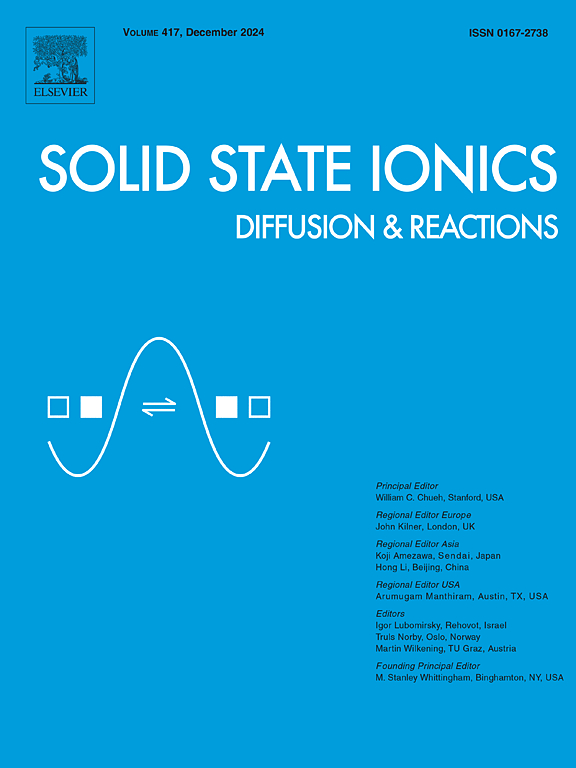High conductivity of a fuel cell through a hydrogen bond network within an interpenetrating anion exchange membrane
IF 3
4区 材料科学
Q3 CHEMISTRY, PHYSICAL
引用次数: 0
Abstract
A series of anion exchange membranes (AEMs) with highly ion conductivity suitable for practical application in fuel cells were prepared in this paper. Polysulfone (PSf) was used as backbone to prepare chloromethylation polysulfone (CMPSf). Then the synthesized CMPSf was blended with tetramethyldiaminopropane (TMPDA) and polyethylene glycol (PEG 400), to construct interpenetrating polymer networks with hydrogen-bonding conduction sites. In this paper the chemical structure of the AEM is confirmed by nuclear magnetic resonance spectrum (1H NMR) spectroscopy and fourier transform infrared spectroscopy (FT-IR). The morphologies of synthesized membranes in this paper are investigated by scanning electron microscopy (SEM) and atomic force microscopy (AFM). The electrochemical and physical properties of AEMs are tested comprising water uptake (WU), ion exchange capacity (IEC), alkaline stability, thermal stability and mechanical stability. The introduction of hydrogen-bonding networks enhanced the OH− conductivity of the membranes (from 37.03 mS·cm−1 of QAPSf-PEG0% to 104.67 mS·cm−1 of QAPSf-PEG30%). The interpenetrating polymer networks make the membranes have good mechanical property (tensile strengh is 19.61 MPa, elongation at break is 20.30 %) and anti-swelling properties (29.3 %, 80 °C). Due to the introduction of hydrogen-bonding conduction networks, the alkaline stability of the AEMs can be enhanced by reducing the modification of the polysulfone backbone. Thus, even after soaking in 6 mol·L−1 KOH solution for 30 days, the retained OH− conductivity of QAPSf-PEG30% still reached 92.0 %. At the same time, the addition of PEG leads to the increased water uptake, so that the OH− ions could be better transported. And the single cell performance of QAPSf-PEG30% was also revealed that the power density increases significantly from 323.35 mW·cm−2 at 60 °C to 514.8 mW·cm−2 at 80 °C as the temperature increases. Overall, QAPSf-PEG30% exhibits promising development potential in the fuel cells.

通过互穿阴离子交换膜内的氢键网络实现燃料电池的高导电性
本文制备了一系列适合燃料电池实际应用的高离子传导性阴离子交换膜(AEM)。以聚砜(PSf)为骨架,制备氯甲基化聚砜(CMPSf)。然后将合成的 CMPSf 与四甲基二氨基丙烷(TMPDA)和聚乙二醇(PEG 400)混合,构建具有氢键传导位点的互穿聚合物网络。本文通过核磁共振谱(1H NMR)和傅立叶变换红外光谱(FT-IR)证实了 AEM 的化学结构。本文通过扫描电子显微镜(SEM)和原子力显微镜(AFM)研究了合成膜的形态。测试了 AEM 的电化学和物理性质,包括吸水率(WU)、离子交换能力(IEC)、碱性稳定性、热稳定性和机械稳定性。氢键网络的引入提高了膜的羟基电导率(从 QAPSf-PEG0% 的 37.03 mS-cm-1 提高到 QAPSf-PEG30% 的 104.67 mS-cm-1)。相互渗透的聚合物网络使膜具有良好的机械性能(拉伸强度为 19.61 兆帕,断裂伸长率为 20.30%)和抗溶胀性能(29.3%,80 °C)。由于引入了氢键传导网络,AEM 的碱性稳定性可以通过减少聚砜骨架的改性来提高。因此,即使在 6 mol-L-1 KOH 溶液中浸泡 30 天,QAPSf-PEG30% 的羟基传导率仍能达到 92.0%。同时,PEG 的加入增加了吸水性,从而使 OH 离子能更好地传输。QAPSf-PEG30% 的单电池性能也显示,随着温度的升高,功率密度从 60 °C 时的 323.35 mW-cm-2 显著增加到 80 °C 时的 514.8 mW-cm-2。总之,QAPSf-PEG30% 在燃料电池中具有广阔的发展前景。
本文章由计算机程序翻译,如有差异,请以英文原文为准。
求助全文
约1分钟内获得全文
求助全文
来源期刊

Solid State Ionics
物理-物理:凝聚态物理
CiteScore
6.10
自引率
3.10%
发文量
152
审稿时长
58 days
期刊介绍:
This interdisciplinary journal is devoted to the physics, chemistry and materials science of diffusion, mass transport, and reactivity of solids. The major part of each issue is devoted to articles on:
(i) physics and chemistry of defects in solids;
(ii) reactions in and on solids, e.g. intercalation, corrosion, oxidation, sintering;
(iii) ion transport measurements, mechanisms and theory;
(iv) solid state electrochemistry;
(v) ionically-electronically mixed conducting solids.
Related technological applications are also included, provided their characteristics are interpreted in terms of the basic solid state properties.
Review papers and relevant symposium proceedings are welcome.
文献相关原料
公司名称
产品信息
阿拉丁
Polysulfone (PSf)
阿拉丁
dichloromethane (CH2Cl2)
阿拉丁
trimethylchlorosilane
阿拉丁
N,N,N′,N′-tetramethyl-1,3-propanediamine
阿拉丁
anhydrous ethanol (C2H5OH)
阿拉丁
polyformaldehyde
阿拉丁
dimethylacetamide (DMAc)
阿拉丁
potassium hydroxide (KOH)
阿拉丁
sodium hydroxide (NaOH)
阿拉丁
concentrated hydrochloric acid
阿拉丁
Polyethylene glycol (PEG 400)
阿拉丁
Chloroform-D (CDCl3)
 求助内容:
求助内容: 应助结果提醒方式:
应助结果提醒方式:


